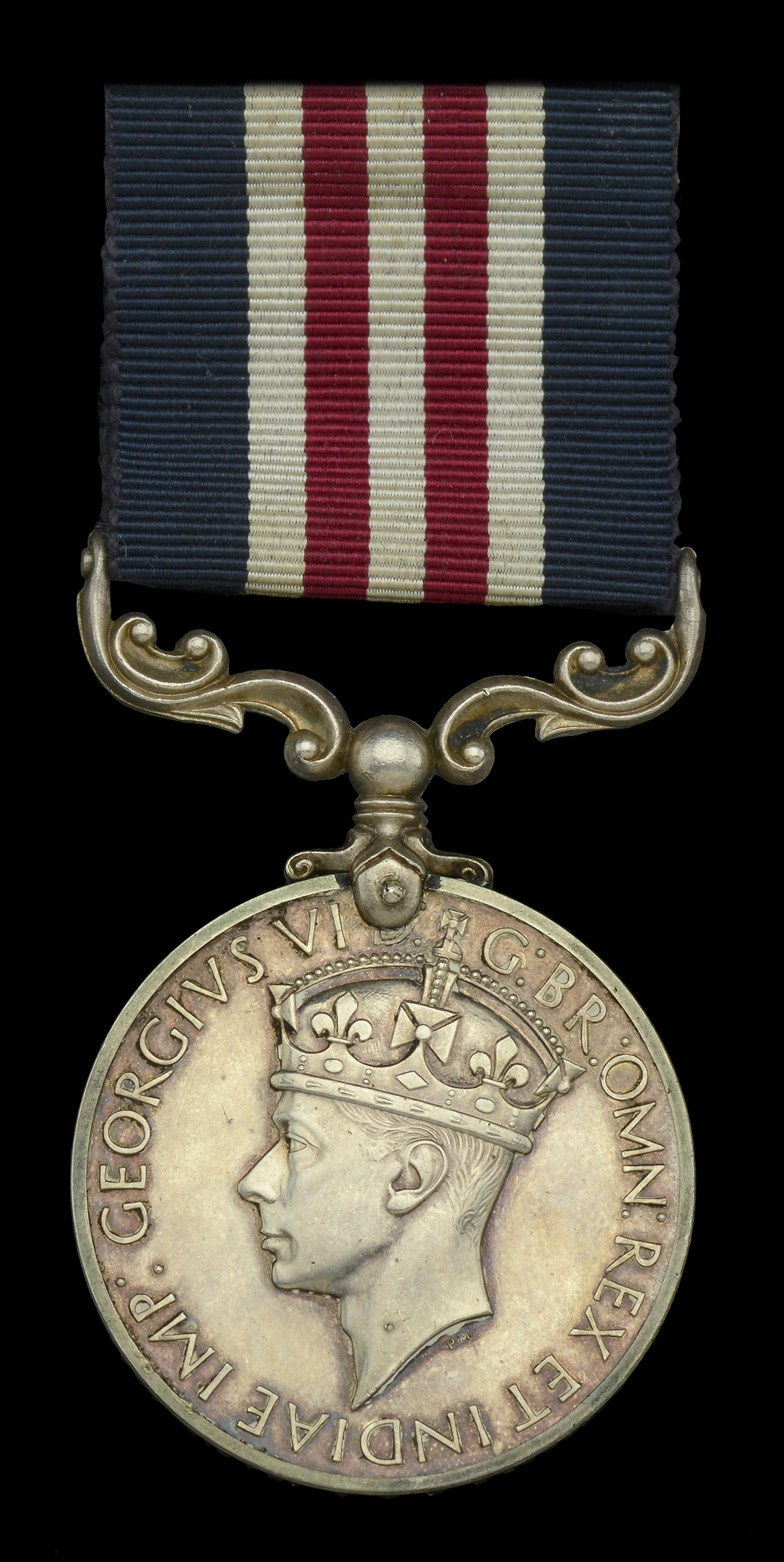The superb and rare Second War ‘Battle of Kangla Tongbi’ M.M. awarded to Sub Conductor, later Warrant Officer Class 1, R. W. Parker, 221 (I) Advance Ordnance Depot, Royal Army Ordnance Corps, for his heroism as part of the epic defence of his unit’s depot during a night attack (6/7 April 1944) from men of the 33rd Japanese Division advancing on Imphal. Greatly outnumbered the small detachment put up a stiff defence against frontline troops, with Parker leading a counter-attack against a Japanese machine gun position after the depot perimeter had been breached Military Medal, G.VI.R. (10537437 W.O. Cl. 1. R. W. Parker. R.A.O.C.) mounted on investiture pin, good very fine £1,600-£2,000 --- M.M. London Gazette 5 October 1944: ‘Throughout the operation at Kangla-Tongbi between 29th March and 7th April 1944, Condr. R. W. Parker, invariably showed exemplary courage and resource. He specially distinguished himself in action at Kangla-Tongbi on 7th April 1944. The enemy were attacking Lion Box and had penetrated into the Box on the Western perimeter over-running an M.E. Coy and setting up L.M.G. posts on 221 A.O.D. perimeter. During his patrol’s counter attack Condr. R. W. Parker, on his own initiative and in the face of heavy L.M.G. fire organised a party of one B.O.R. and 2 I.O.R.s to attack a Japanese L.M.G. post established in a Basha and from which a B.O.R. had shouted for help. Condr. R. W. Parker succeeded in retaking the Basha thereby rescuing one wounded B.O.R. and recovering the bodies of the two dead B.O.R.’s. Three Japanese O.R.s were killed by Condr. R. W. Parker’s party in this action alone.’ Ronald Wright Parker was a native of Grangetown, Cardiff. He served during the Second World War with 221 (I) Advanced Ordnance Depot, Royal Army Ordnance Corps as part of the 14th Army in Burma, and distinguished himself during the Battle of Kangla Tongbi, as part of the Battle of Imphal. The depot position came under night attack from 4 April 1944, with the men tasked with moving the depot supplies out of the position on and to Imphal during the day. Further detail of what has been described as the ‘Normandy of the East’ is provided in an article written by Lieutenant Colonel Mohit Vaishnava for the Indian Ministry of Defence, covering the Platinum Jubilee of the Battle of Kangla Tongbi in 2019: ‘The Battle of Kangla Tongbi, considered one of the fiercest battles of World War II, was fought by Ordnance personnel of 221 Advance Ordnance Depot (AOD) on the night of 6/7 April 1944. Japanese forces had planned a three pronged offensive to capture Imphal and the surrounding areas. In their attempt to extend their line of communication to Imphal, the 33rd Japanese Division cut in behind the 17th Indian Division at Tiddim (Mynmar) and establishing themselves firmly on the main Kohima – Manipur highway, started advancing towards Kangla Tongbi. Here at Kangla Tongbi, a small but determined detachment of 221 AOD put up stiff resistance against the advancing Japanese forces [60th Regiment]. The position of 221 AOD was not at all sound from a tactical point of view. It was exposed to the enemy from all sides and had to rely on its own combatant manpower for its defence. Major Boyd, the Deputy Chief of Ordnance Officer (DCOO) was made in charge of the operations for defence of the Depot. A Suicide squad comprising of Major Boyd, Havildar/ Clerk Store Basant Singh, Conductor Panken [sic] and other personnel from the Depot was created. On 06 Apr 1944, orders were received to evacuate 4,000 tons of ammunition, armaments and other warlike stores. On the night of 6/7 Apr 1944, the Japanese mounted a heavy attack on the Depot, rushing downhill into a deep nullah which was used as a covered approach to the Depot. A very well camouflaged bunker had been sited by the Depot on this approach. The Bren Gun Section in this bunker having spotted an enemy section within range, opened fire. This shook the enemy and forced the Japanese to withdraw leaving many dead. The Bren Gun was manned by none other than Hav/ Clerk Store Basant Singh. For this act of gallantry, Major Boyd was awarded the Military Cross (MC), Conductor Panken [sic], the Military Medal (MM) and Hav/ Clerk Store Basant Singh, the Indian Distinguished Service Medal (IDSM). The Kangla Tongbi War Memorial is a mute testimony to this battle and the unflinching devotion to duty of the Ordnance personnel of 221 AOD, 19 of whom made the supreme sacrifice. It conveys to the world at large that Ordnance personnel, apart from being professional logisticians, are second to none in combat, being equally proficient soldiers, should the occasion demand. As it commemorate the Platinum Jubilee of this hard fought battle, the spirit of Kangla Tongbi lives eternally in the hearts of all Army Ordnance Corps personnel of the Indian Army and continues to be source of inspiration for all ranks.’ A total of 105 British and Indian troops were killed during the battle.
Auctioneer's Buyers Premium: 24% (+VAT)
There is an additional charge of 4.95% (+VAT/sales tax)
See Full Terms And Conditions





